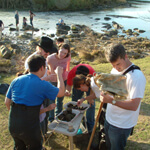
Nine students from the Harvard University School of Public Health and one from the Tulane University School of Public Health and Tropical Medicine visited Laredo in January as part of an environmental medicine program offered by the Health Science Center and a host of Laredo partners.
This is the second year in a row that the Harvard public health school has chosen the Health Science Center’s South Texas Environmental Education and Research Program (STEER) for its students’ winter session training.
Among other activities, the Harvard students and Tulane student worked in breakout sessions with 150 school nurses from the Laredo and United Independent School Districts on how to help parents of children with asthma. The sessions took place at the D.D. Hachar Building on the Health Science Center’s Laredo Campus Extension.
“The training was extremely valuable to our nurses,” said Patricia C. Keck, health services coordinator for the Laredo ISD. “Asthma is the most prevalent health condition we encounter in our student population, and the nurses learned how to counsel teachers and parents on how to modify the environment to maximize the students’ health. It is the number one reason for student absenteeism. Both school districts benefited.”
In addition to completing the month-long STEER course, the Harvard and Tulane students spoke with volunteers at Casa de Mesericordia, the Laredo domestic violence shelter. They also participated in a mentor night with Laredo Med/Ed students at the Hachar Building. Med/Ed is a program offered by the Health Science Center to interest young people in health and research careers. The students participated in a panel question/answer session about graduate school.
Timothy Cunningham, Harvard student, said STEER “was a great experience. Our school pushes us to have experiential learning and that’s exactly what STEER is. One thing that stands out is the cooperation between Mexico and Texas on issues of cross-national importance, such as rabies control and water treatment. Another thing that stands out is the whole idea that diseases do not recognize boundaries.”
Cunningham, in his second year seeking a Master of Science in society, human development and health, said he has lived on the East Coast most of his life and has never been exposed to some of the issues present in Laredo. “It makes me think more globally about what problems exist and how to approach them, because public health is an applied science,” he said.
“Harvard gives core credit for its environmental course when students complete STEER. That is significant,” said Roger Perales of the STEER Program.

